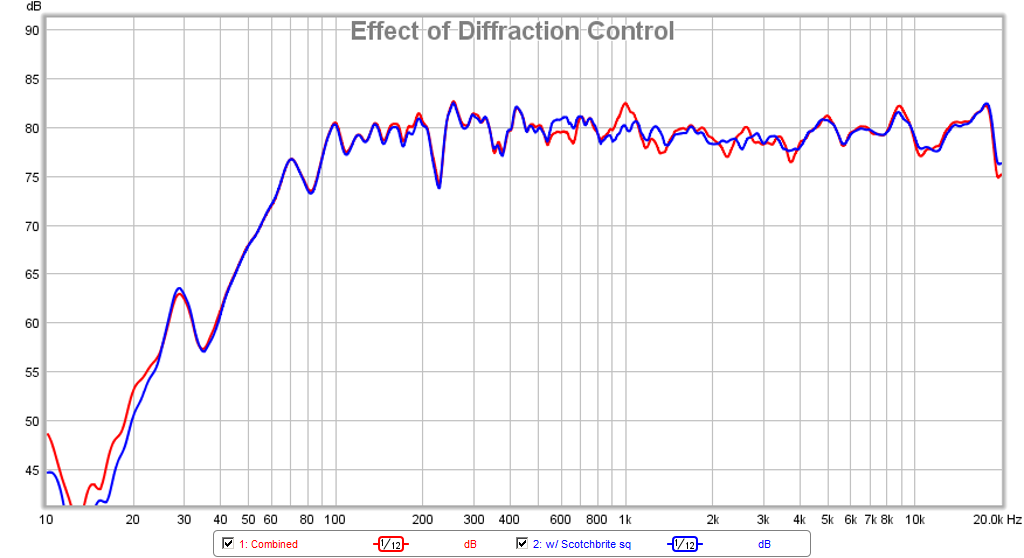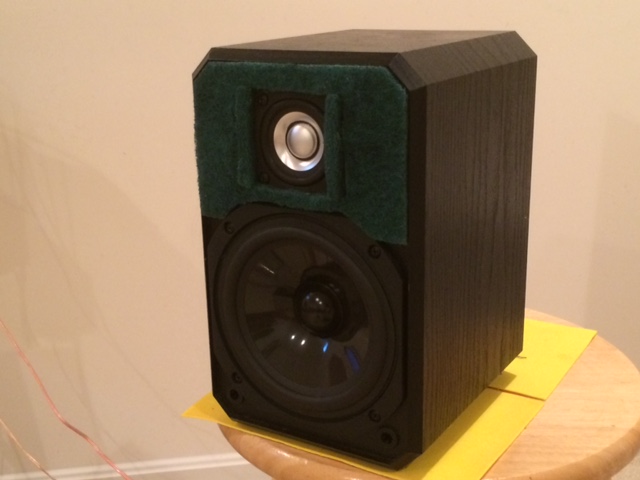Hi Dave,
So there's no point in doing a roundover / chamfer on the edge of the baffle ? (I thought they were used to reduce 'diffraction' and give a smoother transition to 4pi radiation ?) Edit, I think the 'normal' baffle step frequencies are around 200/400 ? Hz whereas the edge diffraction frequencies are higher ?
Cheers,
Rob.
Edit no2 😀 ... I thought you could have a 'smooth' transition from 2 pi to 4 pi and call it 'baffle step', with loads of roundover at the baffle edges, felt, drivers non equidistant from the baffle edge etc.., I also thought there was a separate phenomenon where smaller wavelengths hit the sharp corners of the baffle and 'diffracted', causing a secondary delayed version of the original signal which caused comb filtering/rippling with the original drivers output.
So there's no point in doing a roundover / chamfer on the edge of the baffle ? (I thought they were used to reduce 'diffraction' and give a smoother transition to 4pi radiation ?) Edit, I think the 'normal' baffle step frequencies are around 200/400 ? Hz whereas the edge diffraction frequencies are higher ?
Cheers,
Rob.
Edit no2 😀 ... I thought you could have a 'smooth' transition from 2 pi to 4 pi and call it 'baffle step', with loads of roundover at the baffle edges, felt, drivers non equidistant from the baffle edge etc.., I also thought there was a separate phenomenon where smaller wavelengths hit the sharp corners of the baffle and 'diffracted', causing a secondary delayed version of the original signal which caused comb filtering/rippling with the original drivers output.
Last edited:
While it's basically the same thing, the cause, the effect and the consequences are all complex and varied with distance. Calling it two things is just one way of looking at it.
By the way, if you want to see a neat use of diffraction to transition outward in radiation space, look at the LeCleach horn.
By the way, if you want to see a neat use of diffraction to transition outward in radiation space, look at the LeCleach horn.
I've also found it helpful to think of baffle step and diffraction as two different phenomenon....whether or not their origin is rooted in the same physics/math....because the effects seem to be quite different.
For me baffle step is about pattern control, expressed via angular polar measurements vs freq. (wish it was called baffle 'ramp' instead)
Whereas diffraction is about inference patterns from reflections formed off baffle edges (or other drivers), expressed via ripple measurements in freq response.
For me baffle step is about pattern control, expressed via angular polar measurements vs freq. (wish it was called baffle 'ramp' instead)
Whereas diffraction is about inference patterns from reflections formed off baffle edges (or other drivers), expressed via ripple measurements in freq response.
Well, both effects are diffraction.
It's just that at frequencies where the wavelength is very much larger than the baffle, the two sources (cone and baffle edge) are acoustically very close together. That means there aren't any frequency response anomalies.
As we move up in frequency, there'll be lots of interesting effects as the separation distance becomes large compared to the wavelength.
Of course, there's the confounding variable of driver beaming, which reduces the level of the baffle edge as a secondary source.
Chris
It's just that at frequencies where the wavelength is very much larger than the baffle, the two sources (cone and baffle edge) are acoustically very close together. That means there aren't any frequency response anomalies.
As we move up in frequency, there'll be lots of interesting effects as the separation distance becomes large compared to the wavelength.
Of course, there's the confounding variable of driver beaming, which reduces the level of the baffle edge as a secondary source.
Chris
So there's no point in doing a roundover / chamfer on the edge of the baffle ?
Not at all.
dave
I like “Baffle Ramp” 🙂
We deal with them using pretty different techniques. One is bulk large scale features on the speaker. The other has to do with finer scales, even a small 1mm non flush lip from improper rebate on tweeter can be visible as diffraction ripple.
Whereas the baffle “ramp” has to do more with the size of the baffle. Round overs here won’t change the “ramp” very much. Only the small higher frequency ripples.
We deal with them using pretty different techniques. One is bulk large scale features on the speaker. The other has to do with finer scales, even a small 1mm non flush lip from improper rebate on tweeter can be visible as diffraction ripple.
Whereas the baffle “ramp” has to do more with the size of the baffle. Round overs here won’t change the “ramp” very much. Only the small higher frequency ripples.
Hi Xrk971,
It would be easy to know for you as yu made both foam and wood box to know the difference with absorption and difraction... certainly just at higher frequency 2k and above where anyway the bafle step are at the end hard to rule without a sphere bafle... - I think to the small peaks and deeps in the tweeter area !
WHich makes me think to the square felt around the tweeter in the Dunlavys... if it was to tame the mids for the tweeter than to rule tweeter difractions ?
It would be easy to know for you as yu made both foam and wood box to know the difference with absorption and difraction... certainly just at higher frequency 2k and above where anyway the bafle step are at the end hard to rule without a sphere bafle... - I think to the small peaks and deeps in the tweeter area !
WHich makes me think to the square felt around the tweeter in the Dunlavys... if it was to tame the mids for the tweeter than to rule tweeter difractions ?
Hi Xrk971,
It would be easy to know for you as yu made both foam and wood box to know the difference with absorption and difraction... certainly just at higher frequency 2k and above where anyway the bafle step are at the end hard to rule without a sphere bafle... - I think to the small peaks and deeps in the tweeter area !
WHich makes me think to the square felt around the tweeter in the Dunlavys... if it was to tame the mids for the tweeter than to rule tweeter difractions ?
FR58EX and AC130F1 micro-FAST / WAW
Effect of felt around full range mid tweeter (or Scotchbrite dish scrubber pads):

Seems to smooth out 700Hz to 5kHz range.

FR58EX and AC130F1 micro-FAST / WAW
Effect of felt around full range mid tweeter (or Scotchbrite dish scrubber pads):
Seems to smooth out 700Hz to 5kHz range.
Interesting. I think if the tweeter were a true point source, we would have the drop in sensitivity from full-space radiation due to the absorption (very effective at high frequencies I suspect), but we don't see it because the tweeter does not have good off-axis radiation at those frequencies (i.e. the FR58EX is probably down by 6-10 dB, if not more, at 90 degrees off-axis at 20 kHz).
Btw talking about off axis and difraction and seing again two good datasheets : dynaudio d260 and d330d...the off axis since 15 degree is important...not allflat off axis nore constant directivity tweeters but theysound quite good...
... I also listen to a 3/4 dome of an old Proac which is a ScanSpeak with a foam pad on the face plate.... when seing the datasheet the tweeter has nothing special for it nore the off axis of a 3/4 dome but subjectivly the treble is neutral, a little meaty in the low treble which is nice for instrumentals.
This time in Edge difraction programe the positioning of a 19 mm tweeter (the Peerless 3,1 cm without front plate OCX19etc... 😉 (thanks 456casull for the ref)... it's quite complicate for me to deal with the bafle step and the difraction on a 40 cm high x 19 cm width front bafle... and not sure without bafle it's even better ?! The tear drop à la B&W is maybe not as ideal as it looks and a carefully positioning of the treble is th elistening position is known sees as a beginner as I, a better option ?! 😕 .... and defintly with felt 🙂
This time in Edge difraction programe the positioning of a 19 mm tweeter (the Peerless 3,1 cm without front plate OCX19etc... 😉 (thanks 456casull for the ref)... it's quite complicate for me to deal with the bafle step and the difraction on a 40 cm high x 19 cm width front bafle... and not sure without bafle it's even better ?! The tear drop à la B&W is maybe not as ideal as it looks and a carefully positioning of the treble is th elistening position is known sees as a beginner as I, a better option ?! 😕 .... and defintly with felt 🙂
- Home
- Loudspeakers
- Multi-Way
- Baffle step when the baffle is nearly completely absorptive